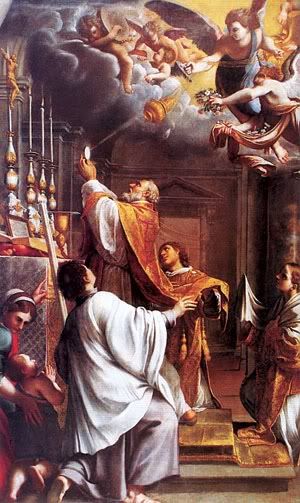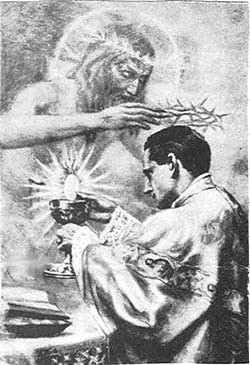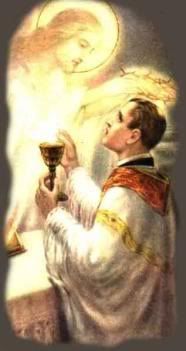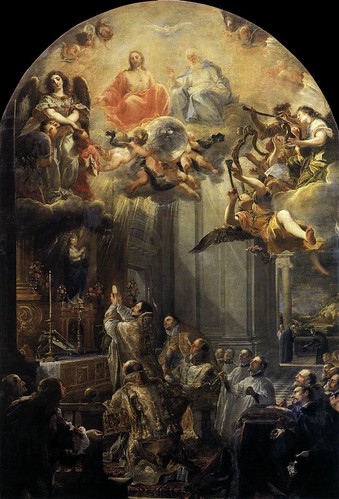It is assumed that, from now on, all we need to do is ‘accept Jesus Christ in our hearts and in our lives as our personal Lord and Saviour’, and that’s it. We’re saved. Nothing can prevent us from going to heaven. But it is a mistake. Of course, a personal commitment to know, love and serve Our Lord Jesus Christ here in this life is necessary if we are to receive the super-abundantly great reward He promised – Himself. Yet, it is not true that He had come to destroy everything Hebrew. On the contrary, He came not to destroy, but to fulfil. The kingdom of David was restored in the Church that Jesus founded.
What the Hebrews had in figure, the Church has in reality – the Pascal meal and the Eucharist; the sacrifice of the Pascal lamb and the sacrifice of the Lamb of God.

To better understand the Mass, the Eucharist, we must take a look into the meaning of the Pascal meal in the Old Testament. In Egypt, the Hebrews were not merely enslaved by Pharaoh: they were also enslaved to the sin of ecumenism with idolatry. To free them from both slaveries, God Our Lord prescribed a ceremony, a rite, a liturgy for them to perform. Please note: He did not prescribe an act of Faith, like ‘Accept Yahweh in your heart as your personal Lord and Saviour and you will be freed from slavery’. Nothing of the sort; God commanded a specific ritual to be performed, that of the Pascal lamb. The details are found in Exodus 12:3-13; 21-27 and 43-49.
The Hebrews had no choice but to obey: God gave no explanations, meaningful or meaningless, they just had to do it, otherwise their firstborn would die. Thus, to spare the life of their firstborn, all Israelite families had to: 1. Sacrifice a male, unblemished lamb, slaughtered during the evening twilight. 2. Ensure no bones were broken. 3. They were to eat its flesh with unleavened bread and bitter herbs. 4. They were to use a branch of hyssop to sprinkle the blood of the lamb on their doorposts. 5. They had to celebrate the rite as a memorial in perpetuity. 6. No uncircumcised male foreigner could take part in it.
Remember: it was not an optional ritual, it was a Commandment. Unless they sacrificed the lamb, ate its flesh and sprinkled its blood on the doorposts, their firstborn would die.

Fulfilling the Pascal rite
The Passover liturgy had developed considerably during Jesus’ time, and remains to this day among the Orthodox Jews. I will mention only the most relevant parts. The Mass follows a similar pattern. The Apostles and subsequent Church Fathers perfected it.
The Last Supper was a Jewish Pascal meal, not a brand-new ceremony improvised by Jesus. Among several beautiful liturgical ceremonies, they had four cups of wine: the first cup was called the Kadesh or the blessing of the festival day; the second cup was connected with the singing of Psalm 113; the third cup was the cup of blessing, so-called because it involved the actual meal, the eating of the lamb, the unleavened bread, etc. Then, before the final prayers, they sang the great Hallel Psalms, 114 to 118, and proceeded to drink the fourth cup, which was the climax of the celebration of the Pascal meal.
Let us see the several stages of the liturgy in more detail.

Kadesh: the blessing of the festival day; sanctification of the wine and drinking of the first cup. (It reminds us of the Offertory of the Mass.)What did Jesus do?
Urhatz: a cleansing ritual – washing one’s hands – which all participants can perform or which the leader can perform on behalf of everybody. (At Mass, the priest purifies his fingers with water).
Vatzah: the leader divides the middle matzah bread. (At Mass, shortly before Holy Communion, the priest breaks the consecrated bread.)
Magid: the leader refers to the bread of affliction which the Israelites ate in Egypt. The story of the first Passover night is narrated, which is the explanation of the Pascal sacrifice and the types of bread used, the matzah and the maror; then they recite the first part of the Hallel Psalm (113). The second cup is drunk. (At the Canon of the Mass, the event of the Last Supper is narrated.)
Motzi Matzah: the leader takes the matzah bread and says a regular benediction for bread, then a special one for the matzah. (At Mass, the bread is consecrated).
Shullan Orech: the flesh of the lamb is eaten. (The priest and the faithful receive the Flesh of Jesus, the Lamb of God, in the Eucharist.)
Barech: after saying grace at the end of the meal, the third cup of wine is drunk and hymns of praise are sung. (This is the cup of blessing, which is consecrated by the priest. St Paul says: “The cup of blessing which we bless, is it not a participation in the blood of Christ? The bread which we break, is it not a participation in the body of Christ?” 1 Cor 10:16-17).
Shfoch Hamatcha: a prayer is recited. It asks God to punish the oppressors of the Jews. This is when the cup for Elias the prophet is filled with wine and the door to the outside is opened to welcome the messenger of redemption.
Hallel: the Hallel Psalms of praise, thanks and joy are chanted (114 to 118). The ritual concludes with the wishful assertion: “Next year in Jerusalem!” The fourth cup is then drunk. (Final blessing at Mass, “Go, the Mass has been said.”)
The liturgy closes with Nitzah, (at Low Mass, we recite the final prayers to St Michael as commanded by Pope Leo XIII).
Jesus said: “With desire have I desired to eat this Pasch with you before I suffer” (Lk 22).
1. The Eucharist was instituted during a meal, not just any meal, but a Pascal meal, a detailed and elaborated ritual established by God and perfected by the ancient Hebrew tradition to commemorate the liberation of Israel from Egypt. It was an excellent religious tradition, and Jesus observed it in all of its details.
2. Jesus took bread, and blessed it, and gave it to his disciples. As the leader of the Pascal ritual, he was observing what is called the Magid, when the leader refers to the bread of affliction which the Israelites ate in Egypt. Then come the two types of bread used, the matzah and the maror. The first part of the Hallel Psalm (113) is recited. They prepare to drink the second cup.
3. “And having taken a cup, He gave thanks and said, ‘Take this and share it among you; for I say to you that I will not drink of the fruit of the vine, until the kingdom of God comes’ ”. This was the second cup (Lk 22:17). Then, “And having taken bread…” We can identify the stage of the Passover liturgy in which Our Lord consecrated bread and wine. He consecrated the matzah bread after the second cup of wine.
4. Then came the consecration of the wine – the third cup, the cup of blessing. Saint Luke narrates: “In like manner He took also the cup after the supper, saying, ‘This cup is the new covenant in my blood, which shall be shed for you.’ ” (Lk 22:20).
5. After saying grace at the end of the meal, the third cup of wine is drunk and hymns of praise are sung. Saint Matthew says: “And taking a cup, He gave thanks and gave it to them, saying, ‘All of you drink of this; for this is my blood of the new covenant, which is being shed for many unto the forgiveness of sins. I will not drink henceforth of the fruit of the vine, until that day when I shall drink it new with you in the kingdom of my Father.’ And after reciting a hymn, they went out to Mount Olivet.” (Mt 26:27-30).

This is the only time in which Our Lord speaks of a New Covenant with the people. The Old Covenant between God and man was sealed by Moses with the blood of a lamb at Mount Sinai. The second Covenant is sealed by the New Moses with his own blood – He is the Lamb of God – in the upper room, before He goes to Mount Olivet, en route to Mount Calvary.
Jesus’ priesthood was according to the order of Melchisedech, who offered a sacrifice of bread and wine, and not according to the Aaronic priesthood, which offered a variety of animals as sacrifice.
Jesus says to the Apostles: “Do this in memory of Me”. It was a word of command. Just as the old Pascal liturgy was to be observed in perpetuity, the new Pascal liturgy is also to be observed in perpetuity. This Melchisedechian sacrifice of bread and wine is the realisation of Jesus’ promise made one year before (see John 6).
In Egypt, the lamb’s flesh was to be eaten and its blood sprinkled on the doorposts to save the Hebrews from death. Likewise, we are fed by the flesh of Christ in Holy Communion and saved by the Blood he poured out on the Cross.
“And after reciting a hymn, they went out to Mount Olivet.” (Mt 26:30): so, after they drank the third cup, the cup of blessing, they recited the Hallel hymn and left: no fourth cup was drunk, no Nitzah final prayers said. Jesus had said, “With desire have I desired to eat this Pasch with you before I suffer.” Did He leave the Pasch unfinished? He, who came not to destroy, but to fulfil? Had He perfected the Paschal liturgy by consecrating the mitzah bread and wine of the cup of blessing (the barech), and then cut it short?
No. He was not in a hurry to finish His first Mass. The Liturgy went on. At Mount Olivet, he made the offertory for the final sacrifice: he had to drink the fourth cup of the Pascal liturgy – He had to finish the liturgy. “My Father, if this cup cannot pass away, unless I drink it, thy will be done”.
After Gethsemane, he was crucified on Calvary. Before being crucified, they offered him wine with gall to drink (Ps 68), but He refused it. He was dreadfully thirsty, suffering from loss of blood and in pain. “And they gave him wine mixed with gall: but when he had tasted it, he would not drink’ (Mt 27:34). He had not yet been crucified. The lamb had not yet been sacrificed.
From the Cross, he cried out the Messianic Psalm 21, “Eli, eli, lama sabactani!” (“My God, my God, why hast thou forsaken me”) – the people thought of Elias the great prophet. In the Passover liturgy that is the time for filling the cup of Elias with wine, and opening the door for the messenger of redemption. Now it is the time for the fourth cup, and to finish the liturgy. Jesus says, “I thirst.” (Jn 19:28). I thirst! Why just now? “Now there was standing there a vessel full of common wine, and having put a sponge soaked with the wine on a stalk of hyssop, they put it to his mouth. Therefore, when Jesus had taken the wine, he said, ‘It is consummated’. And bowing his head, he gave up his spirit.” (Jn 19:28-30).

What was consummated? The great redemption liturgy established by God Our Lord, prefigured by the Pascal meal in Egypt and brought into reality by Our Lord Jesus Christ, beginning in the Upper Room and finishing on Calvary!
The fourth cup was the cup of consummation, the climax of the Pascal sacrificial liturgy, with the firstborn Son, the Passover lamb, the unblemished male lamb, with unbroken bones. As John the Baptist said of Jesus, “Behold the Lamb of God, who takes away the sin of the world”! The fourth cup of wine was given to Jesus from a branch of hyssop, the same type of branch that Moses commanded the people to use to sprinkle the blood of the lamb on their doorposts.
To emphasise the priestly nature of the sacrifice, St John takes notice of the fact that Jesus was wearing a seamless tunic, which the soldiers cast lots for. That was the type of tunic worn by the priests when they sacrificed the Pascal lamb. Moreover: the two thieves had their legs broken to speed up their death. But not Jesus; no bone of his was broken, just like the Pascal lamb.
Conclusion
The Passion of Jesus – the sacrifice of the Pascal lamb and the eating of its flesh to redeem mankind – began at the Last Supper in the upper room and ended on Calvary. Therefore, both the sacrifice of the Pascal lamb and the Eucharistic meal began in the Upper Room and ended on Calvary. The Upper Room and Calvary are the two sides of the same coin.
The Mass, as the un-bloody renewal of Christ’s Pascal liturgy, is both a propitiatory sacrifice and a sacred meal, in which the death of the lamb of God is mystically represented by the consecration of bread and wine – separately, to show his death, and by the eating of the flesh of the Pascal lamb in Holy Communion. Christ is present in the sacrifice, He is present in the meal: it is one and the same reality, just as the Pascal lamb was both sacrificed and eaten. That is why St Paul says: “Christ our Passover lamb has been sacrificed. Therefore let us celebrate the feast” (1 Cor. 5:7). What feast? The Passover feast, the sacred meal, the eating of the Lamb’s flesh. It was not enough to slaughter the Passover lamb, it was necessary to eat its flesh, to become one with it, to have union with it.
The Passover Liturgy of the New Covenant kept only one cup of wine, the third cup, the cup of blessing, which contains the blood of Jesus Christ – “This is my blood”.

So the Mass is both a sacred meal and a sacrifice, or a sacrifice and a sacred meal. [It began in the Upper room and ended on Calvary.] The liturgy of the [Traditional] Mass is redolent of the ceremonies of the Passover liturgy, which Jesus desired with great desire to celebrate for our salvation. “Amen, amen I say to you: unless you eat the flesh of the Son of Man and drink His blood, you shall have no life in you. He who eats my flesh and drinks my blood has life everlasting and I will raise him up on the last day. For my flesh is food indeed and my blood is drink indeed. He who eats my flesh and drinks my blood abides in me and I in him. As the living Father has sent me, and as I live because of the Father, so he who eats me, he also shall live because of Me” (Jn 6:54-59).
With what sense of awe, of wonderment, of sacredness, ought we not to participate in the Holy Sacrifice of the Mass, in which the Lamb of God is mystically sacrificed and His flesh eaten for our salvation?
[Taken from "Mass of Ages" May 2008, The Latin Mass Society's quarterly magazine]

 inundado por um mistério de luz que é Deus e N´Ele vi e ouvi -A ponta da lança como chama que se desprende, toca o eixo da terra, – Ela estremece: montanhas, cidades, vilas e aldeias com os seus moradores são sepultados. - O mar, os rios e as nuvens saem dos seus limites, transbordam, inundam e arrastam consigo num redemoinho, moradias e gente em número que não se pode contar , é a purificação do mundo pelo pecado em que se mergulha. - O ódio, a ambição provocam a guerra destruidora! - Depois senti no palpitar acelerado do coração e no meu espírito o eco duma voz suave que dizia: – No tempo, uma só Fé, um só Batismo, uma só Igreja, Santa, Católica, Apostólica: - Na eternidade, o Céu!
inundado por um mistério de luz que é Deus e N´Ele vi e ouvi -A ponta da lança como chama que se desprende, toca o eixo da terra, – Ela estremece: montanhas, cidades, vilas e aldeias com os seus moradores são sepultados. - O mar, os rios e as nuvens saem dos seus limites, transbordam, inundam e arrastam consigo num redemoinho, moradias e gente em número que não se pode contar , é a purificação do mundo pelo pecado em que se mergulha. - O ódio, a ambição provocam a guerra destruidora! - Depois senti no palpitar acelerado do coração e no meu espírito o eco duma voz suave que dizia: – No tempo, uma só Fé, um só Batismo, uma só Igreja, Santa, Católica, Apostólica: - Na eternidade, o Céu! 

